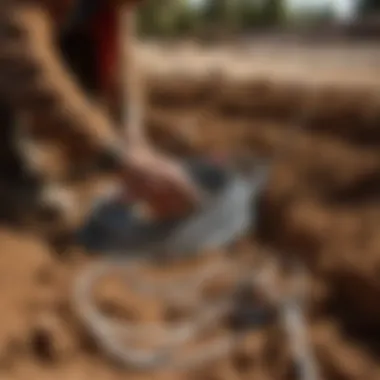Materials:
- Direct burial electrical cable: 500 feet of 12/2 gauge UF-B wire for main power line
- PVC conduit: 100 feet of 2-inch conduit for protection
- Concrete mix: 10 bags for securing conduit in trench
- Wire connectors: Waterproof connectors for splicing wires underground
- Grounding rod: Copper rod for grounding electrical system
- Electrical tape: Insulating the connections
DIY Steps:
-
Planning: Locate the area for trenching and verify power lines' location. Obtain necessary permits.
-
Digging: Excavate a trench 24 inches deep for conduit installation.
-
Conduit Installation: Place PVC conduit in the trench, ensuring it runs from power source to destination.
-
Wire Installation: Feed UF-B wire through conduit, leaving enough at each end for connections.
-
Connection: Connect wires using waterproof connectors, ensuring a secure and weatherproof seal.
-
Grounding System: Install the grounding rod and connect it to the electrical system.
Technical Aspects:
- Tools: Shovel, conduit bender, wire stripper, tape measure, level
- Timing: Plan for at least a full day for trenching and installation
- Techniques: Bending conduit, securing wires, waterproofing connections
DIY Project Process:
-
Trenching: Use a shovel to dig a straight trench following the planned route.
-
Conduit Installation: Bend the conduit as needed and lay it in the trench, ensuring it is level.
-
Wire Installation: Carefully feed the UF-B wire through the conduit, avoiding twists or kinks.
-
Connection and Grounding: Follow manufacturer instructions for proper waterproof connection and grounding.
-
Testing: Test the electrical system to ensure proper functioning and troubleshoot any issues.
Troubleshooting Tips:
- Interference: Ensure wires are properly shielded to avoid interference.
- Faulty Connections: Double-check all connections for any loose or faulty ones.
- Grounding Issues: Verify proper grounding for system safety and functionality.
Overview of Underground Electrical Wiring


In the realm of electrical installations, understanding the nuances of burying electrical wire underground is pivotal. This comprehensive guide sheds light on the intricacies involved, making it an indispensable resource for homeowners and housewives alike. As we venture into the underground realm, we will dissect the various components like materials, labor costs, and permit expenses, offering a complete financial outlook for those considering this route.
Introduction to Underground Wiring
Benefits of Underground Wiring
Delving into the benefits of underground wiring uncovers a plethora of advantages that make it a popular choice among homeowners. The main allure lies in the enhanced aesthetics of having wires concealed underground, enhancing the overall landscape of the property. Additionally, underground wiring mitigates the risk of damage from external elements like storms and fallen trees, ensuring a more reliable power supply. Its superior safety features and durability further solidify its position as a sought-after option for homeowners looking to upgrade their electrical systems.
Considerations Before Installation
Before embarking on the journey of underground wiring installation, several crucial considerations must be taken into account. Planning the layout and design, acquiring necessary permits, and evaluating soil conditions are essential preliminary steps. Understanding the implications of trenching depth, conduit requirements, and material choices ensures a smooth installation process. By addressing these considerations beforehand, homeowners can streamline the installation process and minimize potential challenges down the line.
Necessity of Hiring Professionals
Importance of Skilled Labor
The importance of skilled labor in underground wiring installation cannot be overstated. Professional electricians bring expertise and precision to the job, ensuring that the installation adheres to safety standards and regulations. Their knowledge of wiring techniques, proper equipment usage, and troubleshooting capabilities are instrumental in delivering a high-quality, long-lasting underground wiring system. Investing in skilled labor guarantees a seamless installation process and peace of mind for homeowners.
Regulatory Compliance
Adhering to regulatory compliance is a critical aspect of underground wiring installation to safeguard against potential risks and liabilities. Compliance with local building codes, electrical regulations, and safety standards is non-negotiable when dealing with electrical installations. By partnering with professionals who prioritize regulatory compliance, homeowners can rest assured that their underground wiring project meets all necessary legal requirements, ensuring a safe and compliant electrical system for their property.
Factors Influencing Cost


In the realm of installing electrical wire underground, understanding the factors that influence cost is paramount. The cost of a project is significantly influenced by various elements such as the length of wiring, type of wiring and conduit, and the depth of trenching among others. Each of these factors plays a crucial role in determining the overall cost implications, making it imperative to delve deeper into how they impact the financial aspects of underground electrical wiring installations.
Length of Wiring
Material Quantity
When considering the length of wiring, material quantity emerges as a critical aspect directly affecting the project's cost. The amount and type of wire required can significantly impact the overall expenses. For instance, the quality and quantity of wire needed for extensive underground wiring projects can vary, influencing the total budget allocation. It is essential to select the appropriate material quantity to ensure efficient and effective installation while also taking into account the project's scale and specific requirements.
Labor Hours


Labor hours are another fundamental component in understanding the costs associated with underground electrical wiring projects. The time and effort invested by skilled professionals in installing the wiring underground directly correlate with labor costs. Efficient utilization of labor hours is essential to streamline the installation process and optimize resource allocation. Moreover, labor hours also reflect the expertise and reliability of the workforce involved, emphasizing the significance of skilled labor in executing these projects with precision and efficiency.
Type of Wiring and Conduit
Copper vs. Aluminum Wiring
The choice between copper and aluminum wiring is a crucial decision that influences the overall cost of underground electrical wire installation. Copper wiring is known for its durability and conductivity but comes at a higher price point compared to aluminum wiring, which is a more cost-effective alternative. Understanding the unique characteristics of each type of wiring is essential in making an informed decision based on factors such as conductivity requirements, environmental factors, and budget considerations.
Conduit Material
The type of conduit material selected for underground wiring installations plays a significant role in determining costs. The conduit serves as protective housing for the wiring, ensuring safety and longevity. Factors such as material durability, flexibility, and maintenance requirements influence the choice of conduit material. Additionally, selecting the most suitable conduit material can impact the overall project cost by optimizing resource utilization and minimizing potential maintenance expenses.
Depth of Trenching
Impact on Cost
The depth of trenching is a critical factor that directly impacts the overall cost of underground electrical wiring projects. Deeper trenching requirements can significantly increase installation costs due to additional labor and material expenses. Understanding the impact of trenching depth on project costs is crucial in effectively managing budget allocations and ensuring a cost-effective approach to underground wiring installations. By evaluating the implications of trenching depth on project expenses, strategic decisions can be made to optimize cost-efficiency and project outcomes.
Cost Breakdown
In the realm of underground electrical wiring installations, the cost breakdown holds immense significance. Understanding and analyzing the breakdown of costs involved in burying electrical wire underground is crucial for homeowners and housewives alike. This section meticulously dissects the financial components of the project, shedding light on the investment required for a seamless underground wiring setup.
Materials
When considering the materials required for burying electrical wire underground, three key elements come to the forefront: wire, conduit, and connectors. Each component plays a vital role in ensuring the longevity and efficiency of the electrical wiring system. Let's delve deeper into the importance and characteristics of each material:
Wire
The wire is the very essence of any electrical system, serving as the conduit for electricity to flow through. In the context of underground wiring, the type and quality of wire used significantly impact the overall setup. Copper wire, known for its conductivity and durability, remains a popular choice for underground installations. Its ability to withstand environmental factors and resist corrosion make it a reliable option for ensuring a long-lasting electrical connection. However, it's essential to note that copper wire can be more expensive than aluminum alternatives.
Conduit
Conduit acts as the protective casing for the electrical wire, safeguarding it from physical damage and moisture. Choosing the right conduit material is crucial for the safety and longevity of the wiring system. PVC conduits are commonly used for underground installations due to their durability and resistance to corrosion. While PVC conduits are cost-effective and easy to install, they may lack the robustness offered by metal conduits in certain scenarios.
Connectors
Connectors play a critical role in establishing secure and reliable electrical connections. They facilitate the joint between wires, ensuring a seamless flow of electricity. High-quality connectors are essential to prevent power disruptions and ensure electrical safety. Choosing connectors that meet industry standards and regulations is imperative to maintain the integrity of the underground wiring system. While connectors may seem like small components, their significance in the overall setup cannot be underestimated.
Labor
The aspect of labor is another crucial component in the cost breakdown of underground electrical wiring installations. Understanding the nuances of labor costs, including hourly rates and total installation time, is essential for budgeting and project planning.
Hourly Rates
Hourly rates determine the financial investment required for the skilled labor involved in burying electrical wire underground. Skilled labor is essential for executing the installation with precision and adherence to safety standards. While hourly rates may vary based on location and expertise, investing in experienced professionals ensures the successful implementation of the underground wiring system.
Total Installation Time
The total installation time encompasses the duration needed to complete the underground wiring project. Efficient scheduling and time management are critical in minimizing labor costs and disruptions to daily activities. Experienced professionals can provide accurate estimates of the total installation time based on the scope of the project, helping homeowners plan effectively.
Permit Costs
In addition to material and labor expenses, permit costs form a significant part of the overall cost breakdown for underground electrical wiring installations. Obtaining the necessary permits and complying with regulatory requirements are essential steps in ensuring the legality and safety of the project.
Regulatory Fees
Regulatory fees associated with permits are essential contributions to the cost breakdown. These fees cover the administrative costs of obtaining permits and adhering to local regulations regarding underground electrical installations. While permit costs may vary depending on the jurisdiction and the complexity of the project, budgeting for regulatory fees is essential for a comprehensive cost analysis.
Comparative Analysis
In the realm of installing electrical wire underground, the Comparative Analysis section of this article serves as a pivotal point of reference. This segment ventures into a detailed examination of the stark differences between underground and overhead wiring systems. By delving deep into the financial implications and practical considerations, readers gain a profound insight into the cost dynamics of each method. The Comparative Analysis segment elucidates essential factors that influence decision-making processes in residential or industrial settings.
Underground vs. Overhead Wiring
Cost Considerations
When evaluating the Cost Considerations associated with installing electrical wire underground versus overhead, one must delve into the nuanced interplay of various elements. The primary focus revolves around the initial financial outlay and long-term maintenance expenses. Underground wiring may incur higher installation costs due to trenching requirements and specialized equipment. However, the longevity and reliability of underground systems often overshadow these upfront expenses, making it an appealing choice for those looking for a robust and durable solution. The lower susceptibility to external factors such as weather or accidental damage makes underground wiring a prudent investment for long-term stability and safety.
Long-Term Savings
Exploring the realm of Long-Term Savings in the context of underground versus overhead wiring sheds light on the extended benefits of each approach. While overhead wiring setups may offer cost savings in initial installation due to reduced labor and material expenses, the long-term picture tells a different tale. Underground wiring systems typically exhibit lower maintenance requirements and reduced risk of faults or disruptions, translating into significant savings over the system's lifespan. Moreover, the enhanced safety and aesthetic appeal of underground wiring add further value to the property, contributing to long-term savings through minimized repair and replacement costs. In essence, embracing underground wiring for its long-term savings potential aligns with a strategic and prudent investment approach, ensuring lasting benefits for homeowners and property owners.
Conclusion
In the culmination of this exhaustive exploration into the cost implications of installing electrical wire underground, the importance of the conclusion cannot be overstated. The conclusion serves as a vital summation of the various cost factors discussed throughout the article, offering a concise overview that encapsulates the key considerations for individuals embarking on this endeavor. By synthesizing the material and labor expenses alongside permit costs, the conclusion provides a holistic view of the financial outlay required for underground electrical wiring projects. Housewives and homeowners reading this article will benefit from the insightful recommendations and practical insights shared in the final section.
Summary of Cost Factors
Total Cost Estimates
Total cost estimates play a pivotal role in guiding individuals through the financial planning of underground electrical wiring projects. They provide a comprehensive breakdown of anticipated expenses, encompassing material costs, labor charges, and associated permit fees. The inherent value of total cost estimates lies in their ability to offer a detailed projection of the overall investment required, empowering individuals to make informed decisions regarding budget allocation and expenditure. Emphasizing accuracy and transparency, total cost estimates enhance planning efficacy and aid in establishing realistic financial expectations for homeowners considering underground electrical installations.
Recommendations for Cost-Effective Installation
Optimizing Material Use
Optimizing material use stands as a fundamental aspect of cost-effective underground wiring installations. This strategy involves maximizing the efficiency of material utilization to minimize waste and reduce overall expenses. By carefully selecting the appropriate wire, conduit, and connectors needed for the project, homeowners can streamline procurement costs and enhance budget efficiency. The unique advantage of optimizing material use lies in its potential to deliver significant cost savings without compromising the quality or integrity of the electrical system. Through smart material management practices, individuals can achieve an optimal balance between affordability and performance, making it a preferred choice for prudent homeowners looking to cut down on installation expenditures.
Scheduling Labor Efficiently
Efficiently scheduling labor represents a key tactic for controlling costs during underground wiring installations. By planning labor activities with precision and coordination, homeowners can ensure that installation tasks are completed in a timely and resource-efficient manner. The central characteristic of scheduling labor efficiently is its ability to minimize labor hours without compromising work quality, thereby reducing labor expenses and accelerating project timelines. The distinct feature of this approach lies in its capacity to enhance productivity and cost-effectiveness, making it a strategic choice for homeowners seeking to optimize the financial aspects of their underground electrical projects.





